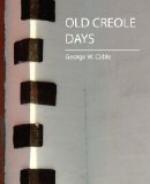BELLES DEMOISELLES PLANTATION.
The original grantee was Count——, assume the name to be De Charleu; the old Creoles never forgive a public mention. He was the French king’s commissary. One day, called to France to explain the lucky accident of the commissariat having burned down with his account-books inside, he left his wife, a Choctaw Comptesse, behind.
Arrived at court, his excuses were accepted, and that tract granted him where afterwards stood Belles Demoiselles Plantation. A man cannot remember every thing! In a fit of forgetfulness he married a French gentlewoman, rich and beautiful, and “brought her out.” However, “All’s well that ends well;” a famine had been in the colony, and the Choctaw Comptesse had starved, leaving nought but a half-caste orphan family lurking on the edge of the settlement, bearing our French gentlewoman’s own new name, and being mentioned in Monsieur’s will.
And the new Comptesse—she tarried but a twelvemonth, left Monsieur a lovely son, and departed, led out of this vain world by the swamp-fever.
From this son sprang the proud Creole family of De Charleu. It rose straight up, up, up, generation after generation, tall, branchless, slender, palm-like; and finally, in the time of which I am to tell, flowered with all the rare beauty of a century-plant, in Artemise, Innocente, Felicite, the twins Marie and Martha, Leontine and little Septima; the seven beautiful daughters for whom their home had been fitly named Belles Demoiselles.
The Count’s grant had once been a long Pointe, round which the Mississippi used to whirl, and seethe, and foam, that it was horrid to behold. Big whirlpools would open and wheel about in the savage eddies under the low bank, and close up again, and others open, and spin, and disappear. Great circles of muddy surface would boil up from hundreds of feet below, and gloss over, and seem to float away,—sink, come back again under water, and with only a soft hiss surge up again, and again drift off, and vanish. Every few minutes the loamy bank would tip down a great load of earth upon its besieger, and fall back a foot,—sometimes a yard,—and the writhing river would press after, until at last the Pointe was quite swallowed up, and the great river glided by in a majestic curve, and asked no more; the bank stood fast, the “caving” became a forgotten misfortune, and the diminished grant was a long, sweeping, willowy bend, rustling with miles of sugar-cane.
Coming up the Mississippi in the sailing craft of those early days, about the time one first could descry the white spires of the old St. Louis Cathedral, you would be pretty sure to spy, just over to your right under the levee, Belles Demoiselles Mansion, with its broad veranda and red painted cypress roof, peering over the embankment, like a bird in the nest, half hid by the avenue of willows which one of the departed De Charleus,—he that married a Marot,—had planted on the levee’s crown.




